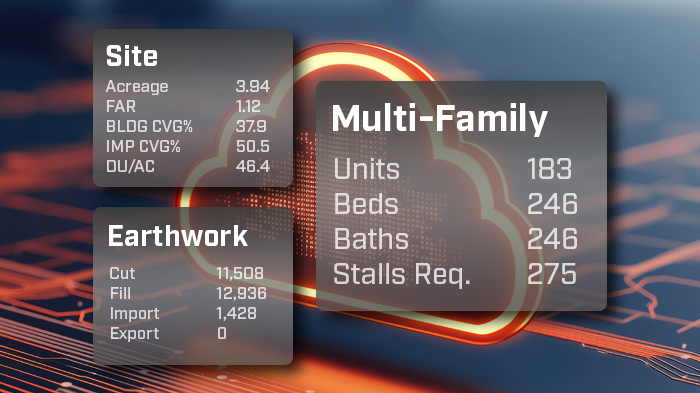
As an architect, how do you serve your clients’ needs more quickly?
Aka: how do you win more work?
Developers are human too. Sometimes impatient. Often questioning your math.
Hands up if you’ve ever heard one of these statements from the multifamily developers you work with:
“We’ve built our own, proprietary units. Please use the attached.”
“What's your Efficiency? We don't build under 83%”
“What's the Mix, I want all the jr. 1Beds. They drive the highest $/SF.”
“We are cost conscious, why do I need so much Vertical Transport?”
“Well this plan is nice but now I need to run the numbers...”
In this article, we'll try to explain the developer's point of view. And better yet, we’ll give you the tools (yes, in TestFit) to help answer their concerns.
If you’re already familiar with TestFit, skip ahead to how you can answer these client questions.

If you’re not familiar with TestFit, think of it as your power tool for rapid site planning & on-the-fly changes. This isn't a generative design tool with optioneering; we call it your building configurator.
The basic premise is we allow you to input constraints in the form of parameters to better shape a density study. But the world is yours in TestFit. You can constrain a site or building as much or as little as you’d like. Your site plan is automatically generated right on top of GIS data. We have co-creation tools built in as well to allow users truly craft their unique vision.
Save your design time for the architectural details that set your firm apart; not redrawing empty boxes. And most important, learn how to speak to multifamily developers in their language.
📢Back to our scheduled programming: answering these tricky questions from the multifamily developers you work with.
1. The proof is in the proprietary units
Developer statement #1: “We’ve built our own, proprietary units. Please use the attached.”
Translation: “They have standardized their costs based on unit prototypes.
You: “No problem, we can add unique units easily.”
Unique Units
Developers like standardization. It's easier to budget and allows them to compare sites faster. TestFit now allows you to put in the unique units that your multifamily developer wants to see.
The way we do this in TestFit is through Attachments. It lives at the top of the Unit Database menu in the configurator panel.

By default, TestFit ships with a set of basic unit layouts for you to replace with your unique units. Click Editor and the unit you would like to edit. You’ll see the standard units in there. It's a simple image upload to keep the program light and moving quickly.
Here is how easy it is to upload your unique units! Be warned, there's a long line of units. That’s by design. If your Developer has 30 unit prototypes, you and I both know that it won’t be efficient to use all of them in a single building. It’s easy for you to upload all of those units though on one image sheet and recalibrate your units based on the select few you need for your building.
Pro-Tip: Flex on ‘em.
Some sites require wonky angles which are not conducive to standard units. So you’ve gotta add some flex parameters to the units. In the unit editor on the parameter panel (left side), you can add max linear and angular flex to allow the units to adjust to fit the angles.
Learn more about our Unit Editor in our Knowledge Base
2. Net rentable floor area
Developer: “What's your Net-Rentable Efficiency? We don't build under 83%.”
Translation: “I want to maximize my net rentable square footage.”
You: “We do too! Let's make tweaks to get there.”
Well we don't get out of bed for a fee less than 15% of the total project cost …just kidding!
Efficiency is important. To be clear, we are talking about the efficiency of floor area in the form of Net Rentable Area. But it means more than just efficiently using the floor area. To developers, it directly relates to the efficient use of capital and operational costs.
We’ve done quite a bit of research on Efficiency in multifamily. In fact, that'll be a blog a post for another time, but in short, our key findings are:
1. Dead End Units are the most efficient way to end a corridor.
2. There is a regressive relationship between the number of intersections and a decrease in efficiency.

4. Wrap Products struggle to reach high levels of efficiency.
5. The depth of units has a greater effect on efficiency at smaller numbers and becomes nominal after 30’-35’.

6. Interior corners are a problem child - so much so, we wrote a whole blog on it.
There's a lot to unpack here but hopefully these insights give you some good rules of thumb while test fitting.
We also have the Tabulation Dashboard, your live-updating best friend. On the bottom of the TestFit screen, you’ll see the Tabulation Dashboard. Here you can find all the data relating to the building you’ve been testfitting. Mo’ data, mo’ problems? Not so! Hit the “+ Expand Tabulation” icon to see the values that make up the dashboard, such as Gross Conditioned space, unit breakdowns, facade take offs, space sizes and more! Developers love their data, especially when it can be tracked to the smallest detail.

3. Mix it up - The Unit Mix
Developer: “What's the Mix? I want all the Jr. 1Beds. They drive the highest $/SF”
Translation: “I need to maximize my revenue here. Do you get that?”
You: “No problem, we can easily adjust that.”
*scrambles to TestFit’s Unit Mix Matrix*
Unit Mix Matrix
What we have here is an extremely powerful unit mix configurator that allows you to customize the unit mix to within a few percentage points.

Here you can adjust the weight of units you would like. For instance, the image above shows Studios at a target weight of 40% Studios, 30% -1 Beds, 15% - 2 Beds, and 15% - 3beds. Adjust any of those and you’ll see your building update in real time. You can pack in all the Jr. 1-Beds your developer wants.

4. What's with all the Ups + Downs?
Developer: “We are quite cost conscious on this project, why do I need so much Vertical Transport?”
Translation: “Do we have a need for all the elevators and stairs?”
You: “Code, but let's dive into why!”
Unfortunate fact: fires happen. They are scary. You want your tenants to be able to get out - fast. Stairs are like wearing layers in Chicago; if you have them you can always take them off, but you will be freezing or in trouble if you don’t.
TestFit is parameter driven. A few of those parameters are directly linked to life safety codes. Our verticals menu, for example, references the IBC code, and allow you to customize these as you see fit.

Changes you can make to the Life Safety Parameters include:
- Adjust the Vertical Transport to a per unit basis
- Stairs - ya need ‘em, but can adjust based on units and dead end distances
- Long corridors = Fire doors. TestFit places those for you. You can toggle them on and off on the top of the verticals menu.
In conversations with developers, you can now point to these constraints and give them the ability to request deviations from the code should they see fit.
5. Deal or No Deal?
Developer - “Well this is nice but now I need to run the numbers...”
Translation - “I want to see if this deal pencils before committing.”
You - *Deals Editor has entered the chat*
Understanding and prequalifying a site for development is the bread and butter of your developers. They want to know where to deploy their capital effectively and while design is important, cost & revenue are more top of mind for them. TestFit’s Deals Editor allows you to show your developer you understand the importance of cost & revenue.
Deals Editor + Development Summary
The Deals Editor is typically the last parameter set you will adjust in the test fitting process. With our Deals Editor, you can input the base costs for the project such as land costs, soft costs per unit or cost per SF and more. The buckets for costs are at the top. What’s more: as you adjust the unit mix, the operational costs and income update live in the Development Summary.

TestFit is the first example of a modern CAD tool embedding financial analytics. We're pretty excited about it.
The Deals Editor is a fantastic tool to better frame conversations when evaluating a site with developers. For instance, a developer may want to provide their assumed costs, targeted rents and proposed land value. This allows your design to hopefully fit into the yield on cost that the developer is targeting.
The deals tab really is your secret communication sauce to speak developer. It also:
- cuts down on iterations you do
- improves your back-and-forth communication time with developers
Pro tip: If you select one site, you will see the deal metrics for just that site, but if you have multiple sites, select outside of them and you will see your deal metrics for the entire masterplan.
½ a conclusion
Maybe you’re not fluent in developer yet, but we hope this “Architect’s Guide to Multifamily Developers” has given you some insight into what they value. And tools to help you show that you get it.
We are here for our architects. We want to enable y’all to win more work, faster, through smart design. TestFit removes the need for mundane tasks, like counting parking stalls, and enables you to refocus on the design.
With our world leading co-creation tools and power users like you, we aren’t just making space… we're changing our industry. Who’s with us?






